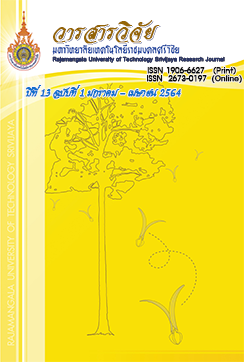Hazard Factors and Musculoskeletal Disorders on Making Artificial Flowers among Home-Based Workers at Banndonfai, Maetha District, Lampang Province
Keywords:
hazard factors, musculoskeletal disorders, home-based workersAbstract
This study aimed to investigate hazard factors and musculoskeletal disorders (MSDs) on artificial flowers among home-based workers at Banndonfai, Maetha District, Lampang Province. The study was a cross-sectional descriptive study. The participants were 164 workers who were selected by purposive sampling technique. The instrument of this research was a questionnaire and rapid upper limb assessment (RULA) techniques. These descriptive statistics were used to carry out the analyses. The results revealed that the most common hazard physical factors, work involves tools that are sharp (95.7%) and, regarding chemical factors, improper storage of chemicals (92.1%) and, regarding biological factors, the worksite is at risk of poisonous insects and animals (83.5%) and, regarding ergonomics factors, chair height improper working seat (94.5%). In addition, MSDs most common in the upper back area (92.1%), shoulders (89%), and lower back (84.1%). The results showed that the mean score of the problem was 7 by RULA techniques indicated that improper working posture high risk must be improved. The results demonstrated that the stakeholder must be aware of problems related to hazard factors and occupational diseases. Including the information obtained to health promotion of the group of home-based workers.
References
Bureau of Occupational and Environmental Diseases. 2019. Documents Related to the Implementation of Surveillance, Prevention, Control of Diseases and Health Hazards from Occupations of Informal Workers / Agricultural Sector. Available Source: http://envocc.ddc.moph.
go.th/contents/view/414, December 12, 2019.
Chaiklieng, S., Kampong, T. and Poochada, W. 2017. Health Risk Assessment on Exposure to Ergonomics Factors among Informal Garment Workers. The Public Health Journal of Burapha University 12(1): 99-111.
International Labour Organization (ILO). 2013. Decent Work Indicators. International Labour Office, Switzerland.
International Labour Organization (ILO). 2015. Home-Based Workers: Decent Work and Social Protection Through Organization and Empowerment. International Labour Office, Jakarta.
Keawnual, A., Lohapoontagoon, B. and Pochana, K. 2017. Prevalence of Work-Related Musculoskeletal Disorders in Various Occupations. The Public Health Journal of Burapha University 12(2): 53-64.
Kentawai, W., Kongtawelert, A., Sujirarat, D. and Bhuanantanondh, P. 2019. Prevalence of Musculoskeletal Disorders among Female Pottery Workers in Khiri Mat, Sukhothai Province, Thailand. Journal of Science and Technology Mahasarakham 38(3): 282-291.
Krejcie, R.W. and Morgan, D.W. 1970. Determining Sample Size for Research Activities. Education and Psychological Measurement 30(1): 607-610.
Kuorinka, I., Jonsson, B., Kilbom, A., Vinterberg, H., Bierring-Sorensen, F. and Andersson, G. 1987. Standardardized Nordic Questionnaires for the Analysis of Musculoskeletal Symptoms. Applied Ergonomic 18(3): 233-237.
Lampang Provincial Statistical Office. 2018. The Informal Employment Survey 2018. Available Source: http://lampang.nso.go.th/
index.php?option=com_content&view=article&id=321:25611&catid=105&Itemid=657, January 9, 2020.
Madtharak, W. 2018. Working Loss Reduction of Para Rubber Plantation Farmers Using Ergonomics Assessment: A Case Study in Manung District, Stun Province Area. The Journal of Industrial Technology 14(1): 13-21.
Mankijkarn, P. and Tantipanjaporn, T. 2017. Factors Related to Respiratory Symptoms of Home-Based Workers: A Case Study of Handmade Cotton Flower Workers in Promburi District, Singburi Province. Journal of Safety and Health 10(36): 34-45.
McAtamney, L. and Corlett, E.N. 1993. Rula: A Survey Method for the Investigation of Work-Related Upper Limb Disorders. Applied Ergonomics 24(2): 91-99.
National Statistical Office. 2018. The Informal Employment Survey 2018. Publications, Labor Statistics Group, National Statistical Office, Bangkok.
Niyomphant, S. 2014. Design and Work Improvement by Ergonomics Principles: A Case Study of the Woven Gold Brocade Textile of Tha Sawang Village at Surin Province. Master’s Thesis in Industrial Engineering, Ubon Ratchathani University.
Office of the National Economics and Social Development Council (NESDB). 2018. National Strategy 2018-2037. Publications, Office of the Secretary of the National Strategy Board, Bangkok.
Pomsunthia, K., Seaping, C., Thongngam, N., Sanguansitthikul, P., Rahong, S., Poomchaveng, S., Jantaluk, A. and Yingratanasuk, T. 2016. Factors Related to Muskulosketal Disorders among Fishery Workers at Angsila Pier, Chon Buri Province, pp. 1-13. In Thailand National Ergonomics Conference 2016. Ergonomics Society of Thailand, Thammasat University.
Sirirat, K. and Taptapaporn, S. 2017. Work Improvement to Reduce Fatigue and Working Posture Risks: A Case Study of Staff in the Joints Assembly Process. Thai Journal of Ergonomics 1(1): 1-7.
Sungkhabut, W. and Chaiklieng, S. 2011. Musculoskeletal Disorders among Informal Sector Workers of Hand-Operated Rebar Bender: A Pilot Study. Srinagarind Medical Journal 26(3): 225-232.
Downloads
Published
How to Cite
Issue
Section
License
The content and information in the article published in Journal of Rajamangala University of Technology Srivijaya It is the opinion and responsibility of the author of the article. The editorial journals do not need to agree. Or share any responsibility.







